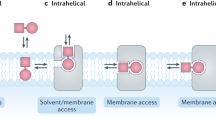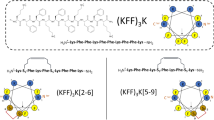Abstract
MANY small molecules modulate membrane functions. Substances such as neurotransmitters interact directly with specific protein receptor sites, whereas others such as anaesthetics, interact with membrane lipids or with hydrophobic regions of membrane. This is consistent with a correlation of their activity with their lipid solubility and lipid–water partition coefficient1. Several lipid-soluble drugs are antihaemolytic2, which correlates not only with their pharmacological activity but also with their ability to expand the lipid bilayer of a biomembrane3. Although expansion of bilayers implies a drug-induced reorganisation of lipids, the mechanism involved remains to be established. We now have evidence that the lipid-soluble drugs may induce a transition of lipid acyl chains from organised gel to randomised liquid crystalline phase. Such drug-induced changes in the lipid phase in a bilayer may affect the function of various membrane-bound proteins4.
This is a preview of subscription content, access via your institution
Access options
Subscribe to this journal
Receive 51 print issues and online access
$199.00 per year
only $3.90 per issue
Buy this article
- Purchase on Springer Link
- Instant access to full article PDF
Prices may be subject to local taxes which are calculated during checkout
Similar content being viewed by others
References
Hansch, C., and Dunn, N. J., J. Pharm.Sci., 61, 1–19 (1972).
Roth, S., and Seeman, P., Nature new Biol., 231, 284–285 (1971).
Seeman, P., Pharmac. Rev., 24, 583–655 (1972).
Fourcans, B., and Jain, M. K., Adv. Lipid Res., 12, 147–226 (1974).
Oldfield, E., and Chapman, D., FEBS Lett., 23, 285–297 (1972).
Oldfield, E., Science, 180, 982–983 (1973).
Rothman, J. E., J. Theor. Biol., 38, 1–16 (1973).
Trudell, J. R., Payan, D. G., Chin, J. H., and Cohen, E. N., Proc. natn. Acad. Sci. U.S.A., 72, 210–213 (1975).
Metcalfe, J. C., Seeman, P., and Burgen, A. S. V., Molec. Pharmac., 4, 87–95 (1968).
Hubbell, W. C., McConnell, H. M., and Metcalfe, J. C., Br. J. Pharmac., 35, 374–375 (1969).
Sullivan, K., Jain, M. K., and Koch, A., Biochim. biophys. Acta., 352, 287–297 (1954).
Shimshick, E. J., and McConnell, H. M., Biochemistry, 12, 2351–2360 (1973).
Author information
Authors and Affiliations
Rights and permissions
About this article
Cite this article
JAIN, M., YEN-MIN WU, N. & WRAY, L. Drug-induced phase change in bilayer as possible mode of action of membrane expanding drugs. Nature 255, 494–496 (1975). https://doi.org/10.1038/255494a0
Received:
Accepted:
Issue Date:
DOI: https://doi.org/10.1038/255494a0
This article is cited by
-
Interactions between volatile anesthetics and dipalmitoyl phosphatidylcholine liposomes as studied by fluorometry with a thiacarbocyanine dye
Journal of Anesthesia (1992)
-
Chlorofluorocarbon interaction with DPPC vesicles: An ESR investigation
Radiation and Environmental Biophysics (1991)
-
Determination of hydrophobicity of myelinic, synaptosomal, and mitochondrial surfaces in the rat brain
Neurochemical Research (1988)
-
Phenothiazines increase active sodium transport across the isolated toad skin
Pfl�gers Archiv European Journal of Physiology (1986)
-
Different concentrations of local anaesthetics have different modes of action on human lymphocytes
Agents and Actions (1983)
Comments
By submitting a comment you agree to abide by our Terms and Community Guidelines. If you find something abusive or that does not comply with our terms or guidelines please flag it as inappropriate.



